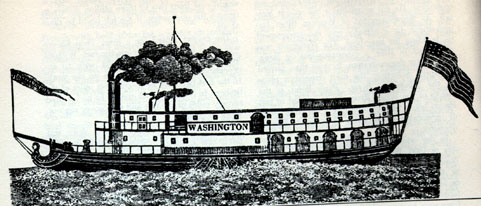 Henry Shreve and his steamboats
Henry Shreve and his steamboats Henry Shreve and his steamboats
Henry Shreve and his steamboats |
| The Washington's boiler exploded during testing. |
French turned Shreve down, undaunted Shreve went about designing and building his own boat in Brownsville, Pennsylvania. Shreve's design was similar to Fulton's New Orleans, but it had significant modifications. Shreve's boat, the Washington, had two decks instead of one, and the boiler was fitted on the lower deck instead of in the hold. The engine itself was of a simpler design, with fewer moving parts. It was positioned horizontally instead of vertically, weighed much less than the older engine designs and could produce around 100 horsepower.
 |
| Shreve's later steamboat, the George Washington, built in 1825. |
The Washington eventually proved to be a reliable boat, although the boiler exploded while Shreve was still testing the steamer. Shreve took the Washington to New Orleans and after squaring off a final time with the Fulton-Livingston group, began to make regular runs with passengers and cargo. With the success of his first design Shreve made further investments in steamboats, building the George Washington in 1825.